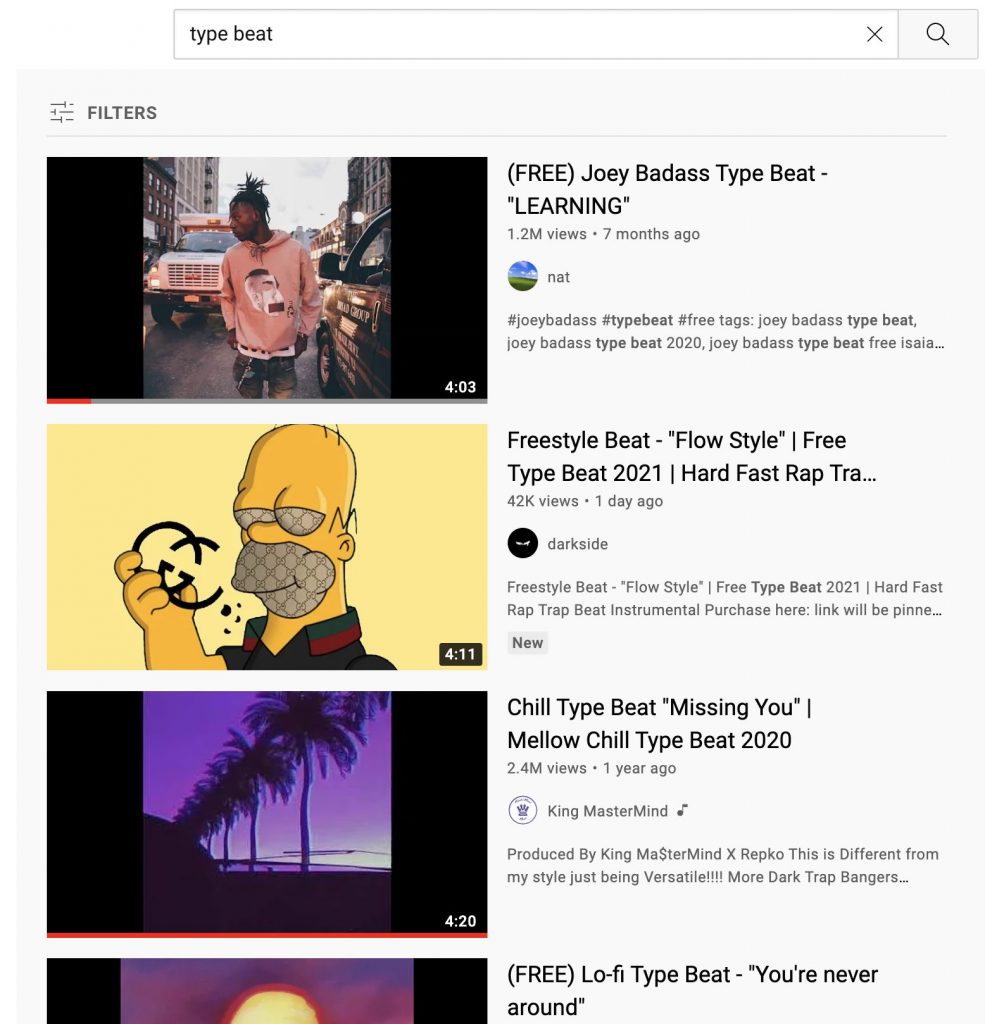This tutorial is for people wishing to know how to write lyrics for a song. Often, our community of aspiring beatmakers, ask us the following questions: “How do you write a song for beginners?”, “Why is songwriting so hard?”, “What can I write my song about?”, “How do you write a song that tells a story?” In order to answer all these questions, in this post we will provide you with a method in 3 steps:

- Step 1: Get inspiration
In this first step, you draft lyrics. You must define the theme of the song and imagine a discussion with a listener around this theme. Write everything down. This process helps go with your stream of consciousness - Alternative: Open a generator
If you need lyrics and you don’t want to take the time to write. You can always skip step 1 and open a lyrics generator online - Step 2: Imagine the lyrics melodies
In the second step, you must find a beat to imagine the voice’s melodies. After identifying the different sections of the beat, you need to sing in the air random words just to decide on the melodies. - Step 3: Adjust lyrics and lyrics melodies
The last step is the merge between step 1 and 2. The idea in this section is to make your lyrics fit with your different voice’s melodies.
Step 1: Get inspiration to write lyrics for a song
Before you structure your lyrics and inject them into your instrumental, the first step would be to write freely and get all your ideas out of your mind. This exercise is some kind of brainstorming session with yourself. Lyrics matter so take time and enjoy this creative ride.
1.1 – Decide on the theme of your lyrics
As simple as it seems, in order to write lyrics for a song, the first step consists of determining the subject that you want to talk about. Make it simple. On a piece of paper, write sentences of 1 to 6 words. For instance, you could want to write a happy song about the fact that : “Friends are very important in life”. If you have different themes in mind, write down your ideas and decide which is worth writing lyrics.

1.2 – Ask yourself questions
Imagine a discussion with a type listener. It could be yourself in the mirror, a friend or a real listener. Imagine what he would ask you about the song’s theme you picked. For instance, if the song’s theme is: “friends are very important in life”; the user could ask :
- “Who are your friends?”
- What would you do for your friends?”
- “How do you know someone is a friend?
1.3 – Define a central question
Define a central question that you will answer during the chorus section of your song. It needs to be the most central question as the chorus summarizes the theme of your song. As a result, other questions will be answered in verses and/or other sections. This central question is essential to not loose your point when you write lyrics for a song.
1.4 – Answer your questions with literal lyrics
You are still communicating with your imaginary listener. He asked you questions and now It’s your time to answer them. At this step, the goal is to write as much as you can.
Don’t be hard on yourself, tell and describe details, actions and emotions when you answer your questions. You will filter, change and adjust the content later. In fact, less is not more at this step of the process, because we don’t want to miss any great lyrics. Just write and go with your stream of consciousness.
While writing, take into account that your listener wants you to be honest with him as he trusts you. That’s why you should write both like you speak and from experience.
Don’t lose your theme and your message! Your words need to be consistent with the theme of the song. However, as it’s often the case to go out of topic, open a new draft and save these pieces of lyrics in your punchline library.
1.5 – Make rhymes to link your sentences
Rhyming is a practice that makes the text catchy. Using rhymes allows you to link your sentences together. Use a dictionary of rhymes if you need to have word ideas for your text.
Although, rhymes are part of the poetry, don’t fall into the trap. Rhymes can’t be forced in the lyrics as they could make the text poorer and not consistent with the central message of your lyrics.
1.6 – Transform your answers into poetic statements
Song making is a free and poetic way to share messages. After your questions have been answered and drafted on your paper, you can now concentrate on finding poetic ways to say ideas that appear too literal.
Keep in mind that the listener needs to be emotionally convinced by the answers you give to them. He must feel that he both understands you and finds himself in your words.
For information, literal lyrics could exclude people who are not in the same exact situation as you. As a consequence, you should mix literal and poetic statements. It gives authenticity to your story and extends the power of your message.
Also, by using poetry, you can push language barriers. Every move is allowed. A short metaphor or even single words can replace long sentences and be more powerful. Although lyrics matter, the quantity of content in the text is not mandatory. It is completely possible to stay light while still transmitting your message to your audience.

1.7 – Pick a song title
The song title is composed of a few words. It is the hook that captures the imagination of the listener. When the listener reads a song title, he already projects himself into the probable questions the singer should be answering in his lyrics.
So make sure, your song title encapsulates the central question of your lyrics.
In this inspiration phase, you have written a bunch of lyrics that are poetic, literal, authentic and that gravitates around the same message. This content constitutes now the essence of your lyrics as you will have to adapt them to your lyrics’ melodies. Plus, the questions that you’ve outlined will help structure your messages across the different parts of your songs (chorus, verses, bridges…).
Step 2: Create lyrics’ melodies for a song
Now that you have written all your ideas during the inspiration phase, it’s time to structure your lyrics for the song. Indeed, your lyrics must be written and sung accordingly with the melody, harmony and rhythm of your beat.
If you haven’t found a beat or instrumental so far, I really recommend you do it as the beat’s structure will help you model your lyrics. Once you have the beat, listen to it carefully, identify the different sections (intro, verse, chorus…) and create a different lyrics’ melody for each one.
2.1 – Find or create an instrumental online
If you need an instrumental, you can use Youtube or Beatstars. For instance, you can type : “type beat Sad’ or “type beat Drake” on Youtube’s search bar and you will have an infinite number of beats at your disposal to help you write lyrics … Usually, they are beats on sale published by professional beatmakers. If you plan to publish a song with the instrumental, either search for Free type beat or go to Beatstars to buy a non-exclusive or an exclusive license.
If you’re up to compose everything by yourself, you can create a professional beat very quickly and easily on lascratcheuse.com
2.2 – Identify the bars’ structure of your instrumental
Your lyrics and voice’s melodies must fit the bars’ structure of your song. Frequently, beats have 6 to 9 sections and can represent a total of 56 to 80 bars.
> Intro (4-8 bars),
> Verse 1 (16 bars),
> Pre-chorus optional (4 bars),
> Chorus (8 bars),
> Bridge optional (4-8 bars),
> Verse 2 (16 bars),
> Pre-chorus optional (4 bars),
> Chorus (8 bars),
> Outro (4-8 bars)
Bars are a portion of time composed of a specific number of beats.
Read this other post to know more about the different song’s structure
2.3 – Create the voice’s melodies
As each part of your song (Verse, Chorus…) needs a different voice’s melody, you must apply the process (that follows) again for each section. Choose which melody you want to create first and start.
“Humming” technique
In general, to search for a voice’s melody, the method naturally consists of singing freely on the beat and choosing the melodies that appeals to you the most. To do so, you can use the “humming” technique or you can select random lyrics drafted during the inspiration phase and sing until you find a catchy voice’s melody.
To find a good voice’s melody, listen to the chord progression of the beat and bounce with it. Also, follow the rhythm supported by drums to bring the appropriate speed and tone to the voice’s melody. Besides, try to inject elongated musical notes. It will give space for vowels and give time for your listener to follow what you’re saying. In the same way, keep space for silences. Besides, silence moments are necessary to take your breath during the song.
Don’t overthink, just sing in the air and dig the best you can do. The more you do this exercise, the better and more diversified your voice’s melodies will be.

Find the number of syllables
When you find a voice’s melody that suits you, start counting the number of syllables you should write to follow your melody. It will be helpful to choose lyrics from step 1 and adapt them to your voice’s melodies. One way to do it is to both sing your melody and count at the same time. More precisely, instead of saying “Hum” or your random lyrics, you just count while singing your melody. In general, when you write lyrics for a song or for poetry, the count of syllables is a frequent practice.
Record all your melodies
Make sure you record yourself with your microphone or your phone. The goal is to remember the various voice’s melodies you imagine. Listen to them to choose which one you want to keep.
Start with voice’s melody for the chorus
The voice’s melody during the chorus needs to be particularly catchy. In fact, the melody must flow smoothly with the melodies of the instrumental. The chorus or hook is essential for a song as It both connects verses and is the part that stays in people’s minds. Keep it simple.
Continue with the voice’s melody for the verses
For verses, you are in a storytelling mode. Most of the time, it’s the section that comprises the most lyrics (but not necessarily). It’s gonna be very important to vary the melody across the 16 bars so that you keep the attention of the listener around what you’re saying. Nothing complicated. Just change radically or slightly your flow each 4 or 8 bars.
In this musical phase, you’ve written voice’s melodies for each part of your beat. At that time, you are able to breakdown your voice’s melodies into a count of syllables. Thanks to this musical phase, you are now able to adjust your text to the beat and write lyrics for a song indeed.
Step 3: Merge lyrics and voices’s melodies
What comes next is the adjustment between your voice’s melodies and the poetic lyrics that you have written in the first step of this tutorial on how to write lyrics for a song. In this third and last step, prepare yourself to revise your text as it needs to flow smoothly with your voice’s melodies. It’s the last step on how to write lyrics for a song.
3.1 – Select lyrics for your voice’s melodies
You must take the number of syllables that your voice’s melody allows and pick lyrics from the inspiration phase considering this number. The consequence of this step is that you may have to combine different ideas into one simple phrase for your message to fit in the lyrics’ melodies. Don’t worry, you can always adapt the melody rather than the text. Another consequence is that you may lose rhymes but as long as you keep some in your text you don’t have to replace them.
When you adapt the text, just be careful that the final lyrics are consistent with the theme of your song and what you have to say.
3.2 – Select lyrics for the chorus melody
During step 1, you have defined and answered a central question for the chorus lyrics. As a reminder, these chorus lyrics must encapsulate the core message of your song. Take a few phrases (1 to 4 short lines) from this part of the text to write the final chorus lyrics.
Although you have a lot of things to say around your central question, the most difficult work is to keep your chorus lyrics simple and short. The chorus must be short for two reasons. First of all, it is the section where you should enhance simplicity and quality (poetry and literary devices) to express your ideas instead of using a large quantity of words. Second of all and obviously, the shorter the chorus text the more likely listeners are to remember your chorus.
3.3 – Select lyrics for a verse
Choose two or three questions from the inspiration phase and use what you’ve crafted for your verses. Start with an interesting statement to immediately catch the attention of the listener.
In the verses, inject as many emotions as you can. Your story must reach the hearts. Give details and context to your story, but not too many because your listener needs time to understand what’s happening in your story.

3.4 – Select lyrics for a bridge
During a musical bridge (or a pause in the song), often represented by a radical change in melody, the singer uses this part of the song to state his emotions in a few sentences. 1 to 3 short phrases should do the work.
3.5 – Sing until your lyrics fit the voice’s melodies perfectly
Sing (and record if possible) your voice’s melodies with the lyrics you selected. Listen to your lyrics in melodies and see if it fits. Just sing and adapt your lyrics. While adapting, always keep the essence of the message intact.
When you feel both having fitting lyrics for all your voice’s melodies and a consistent final text that suits you, you can consider the work done.
Good job 🙂
Long story short
Let’s summarize this post on how to write lyrics for a song. The process itself is a natural stream of actions to go with. Indeed, it only seems natural to write as much as your inspiration allows you and then to adjust them to your voice’s melodies. The trick is to apply yourself in finding catchy voice’s melodies before you adapt your lyrics.
Besides, during this process, we went through various techniques and knowledge such as the discussion with an imaginary listener to launch a stream of consciousness, the structure of a beat, the “humming” technique or even the fact that you should identify the probable number of syllables necessary for your voice’s melodies.
Also, poetry is emphasized in this tutorial. The writer should have a dictionary of rhymes but most of all he should use literary devices to make the text richer and extend its power. Remember that a mix between literal details and metaphorical elements are the secret to both give authenticity to your message and talk to the most people.
Eventually, get an audience to listen to your lyrics and song in order to obtain feedback. The best is to find a listener that is included in your target. Nevertheless, the feedback from your entourage is a start. The whole idea is to get if they are caught by your voice’s melodies and if they feel captivated by your lyrics and your story.


